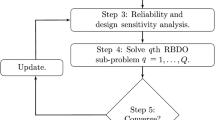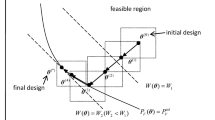Abstract
While surrogate-based optimization has encountered a growing success in engineering design, the development of stochastic metamodels, i.e. capable of representing the complete random responses with respect to random inputs, is still an open issue, although they could be fruitfully used in optimization under uncertainty, both with single and multiple objectives. Therefore, the contribution of the paper is twofold. First, hierarchical stochastic metamodels based on moving least squares and spectral decomposition (by polynomial chaos expansion) are proposed in order to obtain a complete description of the random responses with respect to the deterministic and random input parameters. Then, these metamodels are incorporated into a novel multiobjective reliability-based formulation leaning on the concept of probabilistic nondominance. The whole procedure is applied to an analytical test case as well as to the design optimization of space truss structures, demonstrating the ability of the proposed method to provide accurate solutions at an affordable computational time.















Similar content being viewed by others
References
Acar E, Rais-Rohani M (2008) Ensemble of metamodels with optimized weight factors. Struct Multidis Optim 37:279–294
Acharjee S, Zabaras N (2007) A non-intrusive stochastic Galerkin approach for modeling uncertainty propagation in deformation processes. Comput Struct 85:244–254
Achenie LEK, Ostrovsky GM (2005) Multicriteria optimization under parametric uncertainty. In: Attoh-Okine NO, Ayyub BM (eds) Applied research in uncertainty modeling and analysis. Springer, New York
Barakat S, Bani-Hanib K, Taha MQ (2004) Multi-objective reliability-based optimization of prestressed concrete beams. Struct Saf 26:311–342
Basseur M, Zitzler E (2006) Handling uncertainty in indicator-based multiobjective optimization. Int J Comput Intell Res 2(3):255–272
Beyer HG, Sendhoff B (2007) Robust optimization—a comprehensive survey. Comput Methods Appl Mech Eng 196:3190–3218
Blatman G, Sudret B (2008) Sparse polynomial chaos expansions and adaptive stochastic finite elements using a regression approach. C R Méc 336:518–523
Breitkopf P, Filomeno Coelho R (eds) (2010) Multidisciplinary design optimization in computational mechanics, 1 vol. ISTE/Wiley, Chippenham, 549 pp
Breitkopf P, Rassineux A, Villon P (2002) An introduction to moving least squares meshfree methods. Rev Eur Élém Fin 11(7–8):825–867
Caballero R, Cerdá E, Muñoz MM, Rey L, Stancu-Minasian IM (2001) Efficient solution concepts and their relations in stochastic multiobjective programming. J Optim Theory Appl 110(1):53–74
Coello Coello CA, Van Veldhuizen DA, Lamont GB (2002) Evolutionary algorithms for solving multi-objective problems. Kluwer/Plenum, New York
Crestaux T, Le Maître O, Martinez JM (2009) Polynomial chaos expansion for sensitivity analysis. Reliab Eng Syst Saf 94:1161–1172
Crisfield MA (2000) Non-linear finite element analysis of solids and structures, vol 1. Essentials. Wiley, Chichester
Deb K, Gupta H (2005) Searching for robust pareto-optimal solutions in multi-objective optimization. In: Coello Coello CA, Aguirre AH, Zitzler E (eds) Evolutionary multi-criterion optimization, third international conference, EMO 2005, Guanajuato, Mexico, March 9–11, pp 150–164
Deb K, Gupta H (2006) Introducing robustness in multi-objective optimization. Evol Comput 14(4):463–494
Deb K, Pratap A, Agarwal S, Meyarivan T (2002) A fast and elitist multiobjective genetic algorithm: NSGA-II. IEEE Trans Evol Comput 6(2):182–197
Deb K, Padmanabhan D, Gupta S, Mall AK (2007) Reliability-based multi-objective optimization using evolutionary algorithms. In: Evolutionary multi-criterion optimization. Springer, Berlin
Deb K, Gupta S, Jaum D, Branke J, Mall AK, Padmanabhan D (2009) Reliability-based optimization using evolutionary algorithms. IEEE Trans Evol Comput 13(5):1054–1074
Der Kiureghian A, Ditlevsen O (2009) Aleatory or epistemic? Does it matter? Struct Saf 31:105–112
Eldred MS, Webster CG, Constantine PG (2008) Evaluation of non-intrusive approaches for Wiener–Askey generalized polynomial chaos. In: Proceedings of the 49th AIAA/ASME/ASCE/AHS/ASC structures, structural dynamics, and materials conference, Schaumburg, IL, April 7–10
Filomeno Coelho R, Breitkopf P, Knopf-Lenoir C (2008) Model reduction for multidisciplinary optimization—application to a 2D wing. Struct Multidisc Optim 37(1):29–48
Filomeno Coelho R, Breitkopf P, Knopf-Lenoir C, Villon P (2009) Bi-level model reduction for coupled problems—application to a 3D wing. Struct Multidisc Optim 39(4):401–418
Filomeno Coelho R, Lebon J, Bouillard Ph (2010) Multiobjective reliability-based optimization of truss structures with stochastic surrogate models. In: ECCM 2010 (IV European conference on computational mechanics), Palais des Congrès, Paris, France, May 16–21
Forrester AIJ, Keane AJ (2009) Recent advances in surrogate-based optimization. Prog Aerosp Sci 45(1–3):50–79
Ghanem RG, Kruger RM (1996) Numerical solution of spectral stochastic finite element systems. Comput Methods Appl MechEng 129:289–303
Greco M, Gesualdo FAR, Venturini WS, Coda HB (2006) Nonlinear positional formulation for space truss analysis. Finite Elem Anal Des 42:1079–1086
Gunawan S, Azarm S (2005) Multi-objective robust optimization using a sensitivity region concept. Struct Multidisc Optim 29:50–60
Haftka RT, Gürdal Z (1992) Elements of structural optimization. Kluwer, Dordrecht
Haldar A, Mahadevan S (2000) Reliability assessment using stochastic finite element analysis. Wiley, Chichester
Jones DR (2001) A taxonomy of global optimization methods based on response surfaces. J Glob Optim 21:345–383
Keane AJ (2009) Comparison of several optimisation strategies for robust turbine blade design. J Propul Power 25(5):1092–1099
Klimke A (2008) Sparse grid interpolation toolbox user’s guide, v5.1
Köppen M, Vicente-Garcia R, Nickolay B (2005) Fuzzy-Pareto-dominance and its application in evolutionary multi-objective optimization. In: Coello Coello CA, Aguirre AH, Zitzler E (eds) Evolutionary multi-criterion optimization, Third international conference, EMO 2005, Guanajuato, Mexico, March 9–11, pp 399–412
Kumar A, Nair PB, Keane AJ, Shahpar S (2008) Robust design using Bayesian Monte Carlo. Int J Numer Methods Eng 73:1497–1517
Lancaster P, Salkauskas K (1981) Surfaces generated by moving least squares methods. Math Comput 37(155):141–158
Levi F, Gobbi M, Mastinu G (2005) An application of multi-objective stochastic optimisation to structural design. Struct Multidisc Optim 29:272–284
Li G, Li M, Azarm S, Al Hashimi S, Al Ameri T, Al Qasas N (2009) Improving multi-objective genetic algorithms with adaptive design of experiments and online metamodeling. Struct Multidisc Optim 37:447–461
Limbourg P (2005) Multi-objective optimization of problems with epistemic uncertainty. In: Evolutionary multi-criterion optimization, third international conference, EMO 2005, Guanajuato, Mexico, March 9–11, pp 413–427
Lophaven SN, Nielsen HB, Søndergaard J (2002) DACE—a Matlab kriging toolbox (version 2.0). Tech. rep., Informatics and Mathematical Modelling, Technical University of Denmark
Nayroles B, Touzot G, Villon P (1992) Generalizing the finite element method: Diffuse approximation and diffuse elements. Comput Mech 10:307–318
Paenke I, Branke J, Jin Y (2006) Efficient search for robust solutions by means of evolutionary algorithms and fitness approximation. IEEE Trans Evol Comput 10(4):405–420
Parashar S, Bloebaum CL (2006) Robust multi-objective genetic algorithm concurrent subspace optimization (R-MOGACSSO) for multidisciplinary design. In: 11th AIAA/ISSMO multidisciplinary analysis and optimization conference, Portsmouth, Virginia, September 6–8, AIAA paper 2006-6907
Poles S, Lovison A (2009) A polynomial chaos approach to robust multiobjective optimization. In: Deb K, Greco S, Miettinen K, Zitzler E (eds) Hybrid and robust approaches to multiobjective optimization, Schloss Dagstuhl—Leibniz-Zentrum fuer Informatik, Germany, Dagstuhl, Germany, Dagstuhl seminar proceedings
Sachdeva SK, Nair PB, Keane AJ (2007) On using deterministic FEA software to solve problems in stochastic structural mechanics. Comput Struct 85:277–290
Schuëller GI, Jensen HA (2008) Computational methods in optimization considering uncertainties—an overview. Comput Methods Appl Mech Eng 198(1):2–13
Shan S, Wang GG (2010) Survey of modeling and optimization strategies to solve high-dimensional design problems with computationally-expensive black-box functions. Struct Multidisc Optim 41:219–241
Sinha K (2007) Reliability-based multiobjective optimization for automotive crashworthiness and occupant safety. Struct Multidisc Optim 33:255–268
Stefanou G (2009) The stochastic finite element method: past, present and future. Comput Methods Appl Mech Eng 198:1031–1051
Swiler LP, Wyss GD (2004) A user’s guide to Sandia’s Latin hypercube sampling software: LHS UNIX library/standalone version. Tech. rep., Sandia National Laboratories, Albuquerque, New Mexico
Teich J (2001) Pareto-front exploration with uncertain objectives. In: Evolutionary multi-criterion optimization. LNCS, vol 1993. Springer, pp 314–328
Toal D, Bressloff N, Keane AJ, Holden C (2010) Geometric filtration using proper orthogonal decomposition for aerodynamic design optimization. AIAA J (American Institute of Aeronautics and Astronautics) 48(5):916–928
Tokdar ST, Kass RE (2010) Importance sampling: a review. Wiley Interdisc Rev Comput Stat 2:54–60
Tsompanakis Y, Papadrakakis M (2004) Large-scale reliability-based structural optimization. Struct Multidisc Optim 26:429–440
Viana FAC, Haftka RT, Steffen V Jr (2009) Multiple surrogates: how cross-validation errors can help us to obtain the best predictor. Struct Multidisc Optim 39:439–457
Xiong F, Greene S, Chen W, Xiong Y, Yang S (2010) A new sparse grid based method for uncertainty propagation. Struct Multidisc Optim 41:335–349
Acknowledgements
The authors are grateful to the Institute for the encouragement of Scientific Research and Innovation of Brussels (ISRIB) for their support under a BB2B project entitled “Multicriteria optimization with uncertainty quantification applied to the building industry”. The authors also wish to thank the Reviewers for their fruitful comments.
Author information
Authors and Affiliations
Corresponding author
Appendix
Appendix
To give the closed-form expression of the sensitivities of the limit surfaces b with respect to ξ i (Section 3.2), the chain rule is applied:
Since ψ j is expressed as a product of Hermite polynomials of each variable ξ i :
the derivative of ψ j with respect to a variable ξ i is given by:
If κ i (j) = 0, \(\frac{\partial H_0}{\partial \xi_i}=0\); otherwise, the definition of Hermite polynomials leads to:
Therefore, we obtain explicitly:
and:
where the expression \((\kappa_k(j) H_{\kappa_k(j)-1})\) is equal to 0 when κ k (j) = 0.
Rights and permissions
About this article
Cite this article
Filomeno Coelho, R., Lebon, J. & Bouillard, P. Hierarchical stochastic metamodels based on moving least squares and polynomial chaos expansion. Struct Multidisc Optim 43, 707–729 (2011). https://doi.org/10.1007/s00158-010-0608-5
Received:
Revised:
Accepted:
Published:
Issue Date:
DOI: https://doi.org/10.1007/s00158-010-0608-5




